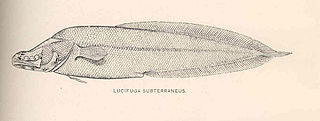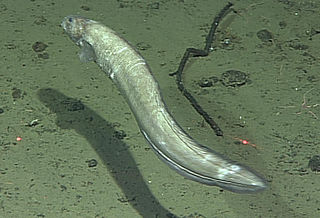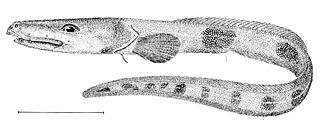The eelpouts are the ray-finned fish family Zoarcidae. As the common name suggests, they are somewhat eel-like in appearance. All of the roughly 300 species are marine and mostly bottom-dwelling, some at great depths. Eelpouts are predominantly found in the Northern Hemisphere. The arctic, north pacific and north Atlantic oceans have the highest concentration of species, however species are found around the globe.

Arctogadus glacialis, known also with ambiguous common names Arctic cod and polar cod, is an Arctic species of fish in the cod family Gadidae, related to the true cod. Arctogadus glacialis is found in icy water. They grow to about 30 cm long, and are favorite food of narwhals and other arctic whales.

The Alert pigfish is a species of marine ray finned fish, a pigfish belonging to the family Congiopodidae. It is the only species in the monotypic genus Alertichthys. This species is endemic to the waters around New Zealand.

Stichaeidae, the pricklebacks or shannies, are a family of marine ray-finned fishes in the suborder Zoarcoidei of the order Scorpaeniformes. Most species are found in the North Pacific Ocean with a few in the North Atlantic Ocean.

The viviparous brotulas form a family, the Bythitidae, of ophidiiform fishes. They are known as viviparous brotulas as they generally bear live young, although there are indications that some species do not. They are generally infrequently seen, somewhat tadpole-like in overall shape and mostly about 5–10 cm (2–4 in) in length, but some species grow far larger and may surpass 60 cm (2 ft).

The scaly gurnard is a species of marine, demersal ray-finned fish from the family Triglidae, the gurnards and sea robins. It is found in the south-western Pacific Ocean.

The Platycephalidae are a family of marine fish, most commonly referred to as flatheads. They are relatives of the popular lionfish, belonging to the order Scorpaeniformes.

Lucifuga is a genus of viviparous brotulas. Most of the species are native to caves and sinkholes in Cuba and the Bahamas; L. inopinata from deep water off the Galápagos Islands is the only exception. The four species rated by the IUCN are all considered vulnerable. The largest species in the genus reaches about 15 cm (5.9 in) in length.

Ogilbia is a genus of viviparous brotulas. The generic name honours the Australian naturalist James Douglas Ogilby (1853-1925), for his contribution to the knowledge of the fishes of Australia.

Pachycara is a genus of marine ray-finned fishes belonging to the family Zoarcidae, the eelpouts. The fishes in this genus are found in the Atlantic, Indian, Southern and Pacific Ocean.
Dermatopsis is a genus of viviparous brotulas.
Majungaichthys is a genus of viviparous brotulas native to the western Indian Ocean. The generic name refers to Majunga in Madagascar where the type was collected.
Mascarenichthys is a genus of viviparous brotulas. They have mostly been collected from the region of Mascarene Plateau in the Indian Ocean and this is referred to in their generic name.
Ogilbichthys is a genus of viviparous brotulas found in the central-western Atlantic Ocean and the Caribbean Sea. he generic name refers to the resemblance of these fish to those in the genus Ogilbia, a name honours the Australian naturalist James Douglas Ogilby (1853-1925), combined with ichthys which means "fish" in Greek.
Tuamotuichthys is a genus of viviparous brotula that lives in the Pacific Ocean.
Bassogigas is a genus of cusk eel from the subfamily Neobythitinae, part of the family Ophidiidae. The generic name "Bassogigas" comes from a combination of two Latin words: bassus, which means "deep" and gigas which means "giant". The species are found in the Indo-Pacific and western Atlantic Ocean.
Lycodes is a genus of zoarcid fish in the subfamily Lycodinae. It is the most species-rich genus in its taxonomic family as well as in the Arctic Ocean and adjacent waters. They occupy both shallow waters and deeper waters down to 3000 meters. A few species can occur in brackish waters.

Lycenchelys is a genus of marine ray-finned fishes belonging to the family Zoarcidae, the eelpouts. The genus has almost cosmopolitan distribution.
Argentinolycus is a monospecific genus of marine ray-finned fish belonging to the family Zoarcidae, the eelpouts. Its only species is Argentinolycus elongatus which is found in coastal southern eastern South America.
Hadropogonichthys is a monospecific genus of marine ray-finned fish belonging to the family Zoarcidae, the eelpouts. The only species in the genus is Hadropogonichthys lindbergi which is in the northwstern Pacific Ocean.









